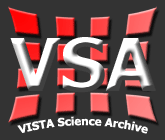The VVV Survey data products offer a unique dataset to map the stellar populations in the Galactic bulge and the adjacent plane and provide an exciting new tool for the study of the structure, content and star formation history of our Galaxy, as well as for investigations of the newly discovered star clusters, star forming regions in the disk, high proper motion stars, asteroids, planetary nebulae, and other interesting objects.
ESO Data Products Generic Query Form
Data Releases:
DR1: http://www.eso.org/sci/observing/phase3/data_releases/vvv_dr1.html
DR2: http://www.eso.org/sci/observing/phase3/data_releases/vvv_dr2.pdf
DR3: http://www.eso.org/sci/observing/phase3/data_releases/vvv_dr3.pdf
DR4: http://www.eso.org/rm/api/v1/public/releaseDescriptions/80
Data Release: The VVV Infrared Astrometric Catalogue (VIRAC) – version 1, Published: 01 Jul 2019
Data Release: VVVX Public Survey First Data Release, Published: 13 Feb 2019
Science Announcement : https://www.eso.org/sci/publications/announcements/sciann17009.html
Data Products Query Form: http://archive.eso.org/wdb/wdb/adp/phase3_main/form?collection_name=VVV&release_name=DR4
The VISTA Science Archive (VSA) is part of the Wide Field Astronomy Unit (WFAU) at the Institute for Astronomy, the University of Edinburgh.
It holds the image and catalogue data products generated by VIRCAM on the Visible and Infrared Survey Telescope for Astronomy (VISTA) .
The primary contents of the archive originate from the VISTA Public Surveys. Survey science-ready catalogue data will be released in phases, while standard flat-file data products (both images and derived single passband catalogues) become available continually after routine observation and processing operations.
 The Cambridge Astronomical Survey Unit (CASU) is part of the Institute of Astronomy, Cambridge University
The Cambridge Astronomical Survey Unit (CASU) is part of the Institute of Astronomy, Cambridge University
The main projects that CASU is currently working on are:
Expertise within the group covers a broad range of ground and space-based projects ranging from data processing and image analysis techniques through to data curation and access to UK facility data archives. Modern era wide-field digital surveys produce vast amounts of data and CASU is at the forefront of automatically processing and archiving these legacy products.
Data reduction
We use the enhanced VISTA Data Flow System3 (VDFS; Emerson et al., 2004; Irwin et al., 2004; Hambly et al., 2004). It includes all basic data reduction steps:
(i) removing instrumental signature (bias and dark frames, twilight, and dome flatfields, linearity, bad pixel maps, cross-talk, gain calibrations), merging paw- prints into tiles and calibrating photometrically and astrometrically;
(ii) extracting source catalogues on a tile-by-tile basis;
(iii) constructing survey-level products – stacked pixel mosaics, difference im- ages, and merged catalogues;
(iv) providing the team with both data access and methods for querying and analyzing the data; and
(v) producing virtual observatory (VO)-compliant data products for delivery to the ESO archive.

Figure 1 shows a flow chart of the data processing. The pipeline products are: astrometrically corrected and photometrically calibrated tiles in each filter used, confidence maps, and homogeneous object catalogues (Cross et al., 2009). The pipeline records the processing history and calibration information of each file, including calibration files and quality control parameters. The Cambridge Astronomy Survey Unit (CASU) component of the VDFS will be responsible for the basic pipeline processing and the first calibration, all done on a daily basis.
Combination/image subtraction (archive)
The “second”-order data processing requires access to larger sets of data to produce survey products. It is carried out by the Wide Field Astronomy Unit’s (WFAU) VISTA Science Archive (VSA) in Edinburgh. The Science Archive contains only calibrated data and catalogues, and no raw data. The Science Archive is responsible for:
(i) image stacking to produce combined and differenced tiles and source merging;
(ii) quality control: assessment of the data quality and filtering of the data that do not meet the established criteria for photometric and astrometric accuracy;
(iii) light-curve extraction: this will be done by implementing an image-subtraction algorithm (Alard & Lupton, 1998; Alard, 2000), which will allow us to create the catalogue of variable sources. This method provides excellent results for crowded fields in which the traditional aperture or PSF-fitting photometry fails (e.g., Kaluzny et al., 2004; Pietrukowicz et al., 2005).

